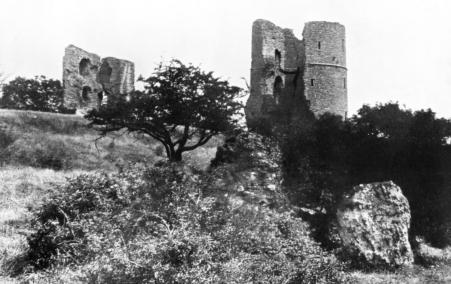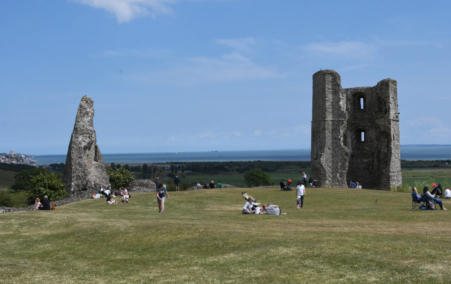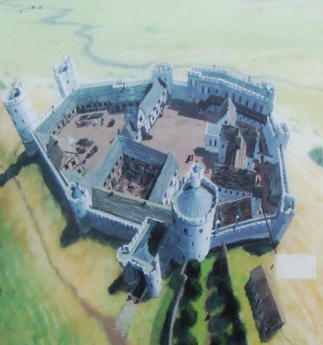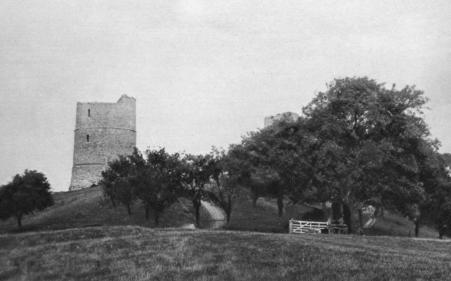Hadleigh Castle
The
manor
of
Hadleigh
was
granted
to
Hubert
de
Burgh,
1st
Earl
of
Kent
and
Chief
Justiciar
of
the
Kingdom,
during
the
reign
of
Henry
III.
Hubert
began
the
construction
of
Hadleigh
Castle,
under
licence
from
the
King,
in
the
years
subsequent
to
1217.
The
chosen
site
was
on
top
of
the
South
Essex
south
ridge,
overlooking
the
Thames
estuary,
which
was
generally
formed
from
soft
deposits
of
London
clay.
It
stood
picturesquely
and
prominently
in
the
centre
of
the
range
of
cliffs,
stretching
from
Leigh
to
Benfleet,
commanding
fine
views
of
the
Thames.
The
structure
was
built
using
Kentish
rag
stone
cemented
by
a
mortar
containing
a
large
portion
of
seashells,
particularly
cockleshells
from
the
cockle
beds
of
neighbouring
Canvey
Island.
The
castle
was
protected
by
square
and
semi-circular
mural
towers,
with
a
barbican
(fortified
gateway)
guarding
the
northern
entrance.
On
three
sides
there
was
a
moat
and
the
fourth
was
amply
defended
by
the
declivity
of
the
slope.
The
area
within
the
castle
walls
was
approximately
110yds/100.5m
long
by
40yds/36.5m
wide.
Hubert
de
Burgh
eventually
fell
out
of
favour
with
Henry
III:
he
was
imprisoned
and
finally
stripped
of
Hadleigh
castle
in
1239.
For
the
remainder
of
the
century
Hadleigh
was
retained
as
a
royal
castle
as
part
of
an
estate
containing
142
acres of agricultural land, the surrounding parkland and the castle mill.
By
the
1250s
the
castle
had
become
neglected
and,
despite
some
investment
after
it
was
given
to
Queen
Eleanor
(1st
wife
of
Edward
I)
in
1273,
it
remained
in
quite
a
poor
condition.
Only
the
mill,
which
was
vital
for
the
operation
of
the
wider
estate,
appears
to
have
been
well-maintained.
A
new
56ft/17m
wide
by
30ft/9m
long
hall
and
an
adjacent
solar
complex
were
built,
at
the
castle
around
1290,
but
they
collapsed
due
to
subsidence
shortly
after.
In
1299
the
castle
was
given
by
Edward
I
to
his
2nd
wife
Queen
Margaret,
who
complained
about
the
quality
of
the
building
and
insisted
that
repairs
were
carried
out.
Edward
I
only
visited
the
castle
twice,
using
it
as
a
base
for
hunting
in
the
area.
Upon
his
death
in
1307
the
castle
passed
to
his
son
Edward
II.
He
first
stayed
there
in
1311,
and
work
was
undertaken
to
renovate
the
castle
prior
to
his
arrival.
The
work
included
building
new
royal
quarters
and
repairing
some
of
the
castle
walls
that
had
succumbed
to
subsidence.
Amongst
the
castle
buildings
known
to
exist
during
the
period
were
the
castle
hall,
larder,
kitchen,
cellar,
a
long
house,
prison,
and
“old
chamber”,
and
armoury;
a
garrison
of
24
soldiers
guarded
the
site
during
crisis.
Edward
stayed
at
the
castle
often
during
his
reign
up
until
1324,
travelling
occasionally
from
London
to
Hadleigh
on
his
royal
barge,
which
docked
at
a
wharf
to
the
south
side
of
the
castle.
In
1326
Edward was deposed by his wife Isabella who took Hadleigh castle from him.
In
1330
their
son,
Edward
III,
acquired
the
castle
when
he
recovered
it
from
his
mother.
He
did
nothing
with
the
castle
until
the
1360s
when
he
significantly
expanded
and
remodelled
the
castle,
turning
it
into
a
much
grander
property
designed,
possibly,
to
defend
against
potential
attack
but
most
likely
as
a
personal
retreat
close
to
London.
Between
1361
and
1363
the
internal
buildings
were
renovated
and
new
royal
lodgings
built
along
the
south
walls,
after
which
the
entire
east
side
of
the
castle
was
rebuilt,
with
two
large
circular
towers
installed
in
a
new
stretch
of
curtain
wall,
completed
by
1365.
The
north
side
if
the
castle
was
rebuilt
to
include
a
main
entrance
with
a
portcullis
and
drawbridge,
protected
by
a
barbican
and
a
large
circular
tower
called
the
“High
Tower”,
which
was
completed
by
1370.
The
engineer
in
charge
is
presumed to have been the celebrated William of Wykeham (1320 -
1404).
Upon
Edward’s
death
in
1377
his
successor,
Richard
II,
made
little
use
of
the
castle
and
he
granted
it
to
Aubrey
de
Vere
until
his
death
in
1400.
From
then
on
the
castle
passed
amongst
a
number
of
high-status
owners,
namely;
Edmund
of
Langley
(1st
Duke
of
York)
and
his
son
Edward
of
Norwich
(2nd
Duke
of
York),
Humphrey
of
Lancaster
(Duke
of
Gloucester),
Richard
(3rd
Duke
of
York),
Edmund
Tudor
(1st
Earl
of
Richmond).
Hadleigh
then
returned
to
the
Crown
and
was
granted
to
Elizabeth
Woodville,
wife
of
Edward
IV,
and
remained
a
Crown
property
until
Henry
VIII.
He
made
no
use
of
the
castle
himself
but
it
formed
part
of
the
dower
of
three
of
his
wives
–
Catherine
of
Aragon,
Anne
of
Cleves
and
Catherine
Parr
–
and
the
castle’s
parks
were
used
as
sources
of
timber for his navy!
In
1551,
Edward
VI
sold
the
castle
to
Lord
Richard
Rich.
During
the
period
between
1551
and
1575,
Lord
Rich
dismantled
the
castle
for
the
value
of
its
stone,
and
the
castle,
now
thoroughly
ruined,
passed
through
Rich’s
descendants,
the
Earls
of
Warwick.
It
remained
in
the
Warwick
family
until
the
Warwick
estates
were
divided.
Since
that
date
Hadleigh
Castle
changed
hands
several
times
until
1890
when
the
castle,
and
its
surroundings,
were
purchased
by
William
booth
for
the
use
of
the
Salvation
Army.
They
established
a
farm
colony
on
the
site
then,
train
the
English
poor
prior
to
them
being
sent
overseas
to
the
British
colonies,
the
farm is still in their ownership to date.
Between
1898
and
1923
considerable
subsidence
and
slippage
on
the
ridge
occurred,
causing
the
southern
curtain
wall
to
collapse.
In
1948
the
Salvation
Army
gave
the
castle
to
the
Ministry
of
Works,
and
it
is
now
owned
by
English
Heritage
and
is
classed
as
a
scheduled
monument
and
a
Grade
I
listed
building.
Unfortunately
subsidence
and
landslips
continued,
with
the
north-east
tower
largely
collapsing
in
the
1950s.
In
1969,
1970
and
2002
further
major
slippages
occurred.
All
that
remains
of
the
once
stately
castle
are:
one
of
the
three-storey
towers
at
the
eastern
side
which
stands
almost
full
height
with
narrow
rectangular
windows
in
the
upper
levels;
the
second
tower
only
has
about
one
third
of
its
original
form;
some
sections
of
the
curtain
wall
have
survived,
as
well
as
the
foundations of the great hall, solars, and the kitchen.
The
ruins
were
painted,
by
John
Constable,
whose
picture
was
engraved
in
mezzotint
by
David
Lucas,
for
the
English
Landscape
series.




Southend Timeline Southend-on-Sea © 2009 - 2024. All Rights Reserved



Website Info:

Southend-on-Sea’s No 1 History Website! Documenting The Town & The Townspeople
Now Incorporating The Sea Of Change Website




1230 Artists Impression of Hadleigh Castle
SOUTHEND CITY
Chalkwell ▪ Eastwood ▪ Leigh-on-Sea ▪ Prittlewell ▪ Shoeburyness ▪ Southchurch ▪ Thorpe Bay ▪ Westcliff-on-Sea
































































